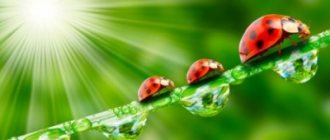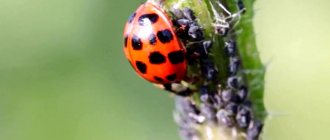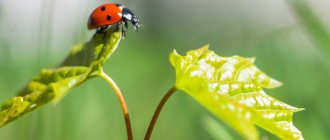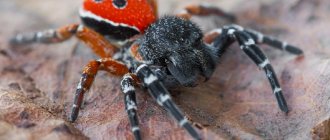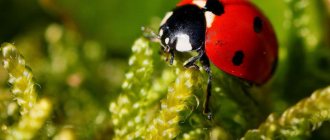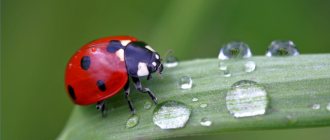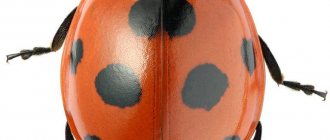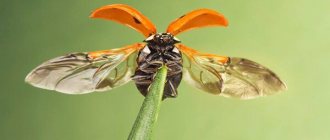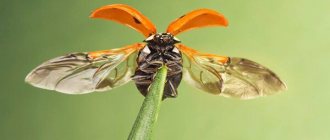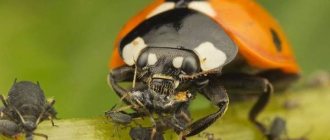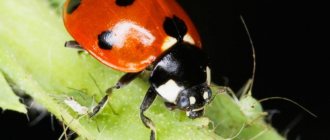What is the relationship between ladybug and aphid. Why is ladybug considered the best remedy against aphids? What you need to know about these insects. How gardeners attract ladybugs to their plots. Popular beliefs. Facts about ladybugs.
We are all familiar with such cute insects as ladybugs. They are capable of not only charming with their rather bright appearance, but are also capable of bringing great benefits to gardeners, as they are ideal assistants in pest control.
It is worth mentioning that for a long time entomologists have been observing the relationships of ladybugs with other insects. It was discovered that the ladybug and the aphid are not on friendly terms. The ladybug destroys the pest, which has become the reason for the widespread use of beneficial insects in agriculture.
Pests
A pest such as aphids is a small, sedentary insect. Adults grow to a maximum length of 8mm. The pest's diet consists of plant sap.
The mouthparts consist of a proboscis, with which they easily pierce the leaf plate and suck out the juice. Aphids secrete a very sweet and healthy substance - honeydew, which ants love. Therefore, very often, when infested with aphids, an anthill is observed in the area.
This small pest is a carrier of dangerous diseases that lead to the death of plants.
They live in fairly large colonies and prefer a mild and warm climate. There are winged and wingless representatives. In autumn, females lay eggs in the bark of trees, near the buds, where they easily survive the winter.
With the arrival of warmth, wingless individuals emerge from the eggs, which attack young plants and begin to actively feed. They can lay offspring without mating, so intensive population growth is observed.
By mid-summer, females with wings are born, which fly to other plants and create new colonies. It is their clutches of eggs that can overwinter, and in the spring everything repeats again.
Features of the aphid lifestyle
The aphid itself is a small insect, the size of which does not exceed a few millimeters. Their body is oval in shape, the cover is lumpy, and the shell is half transparent. Since they are characterized by long legs, it can crawl and even jump to another plant.
Their way of life is somewhat reminiscent of ants - they also live in a colony, each of which has wingless individuals and those with wings. In this case, wingedness is observed in both females and males. An adult insect has antennae that help it distinguish sounds; in addition, they are needed for touch.
The eyes have a multifaceted structure and can be of different shades - from red to dark brown and black. Wingless individuals may additionally have 3 ordinary ocelli. Interesting fact: aphids have much better vision than other insects, and their abilities include distinguishing certain colors.
Speaking about the mouth opening, it is presented in the form of a small proboscis, which has 4 segments. Using the proboscis, the skin of the plant is punctured, and then the juice is consumed. The leaf of a plant that is affected by aphids begins to wither, the shoot stops growing, and hollow protrusions (galls) begin to form on the root. Aphids are capable of infecting every part of vegetation, which is why they are considered one of the most formidable and dangerous pests.
The life cycle of aphids begins with the laying of eggs by the female in the autumn, and larvae emerge from them in the spring. After growing up, they proceed to the process of reproduction through the technique of parthenogenesis, that is, fertilization is excluded. This stage of progeny involves the progeny of only wingless females. In just a month, their number can reach several hundred thousand individuals.
If the colony is overcrowded, the offspring begin to acquire porches, with the help of which they can fly to other vegetation. At the end of summer, males with wings appear in the colony.
After growing up, the process of reproduction involves the participation of individuals of each sex. This option involves fewer eggs per laying. But eggs have the ability to survive winter, but aphids, which hatch first from an unfertilized clutch, will not be able to survive even until the onset of cold weather.
The lifespan of these insects ranges from several days to a month. In the case of cool temperatures (about 8-10 degrees above zero), the life of females is extended by 2 times.
Ladybug
Ladybug activity begins in the spring and continues until late autumn. As a rule, in those places where they spend the summer, they remain for the winter, hiding under fallen leaves, in the bark of trees, under stones.
But there are also ladybugs that do not stay in one place, but migrate. These insects do not live in colonies; they prefer to lead a solitary lifestyle. But before the onset of cold weather, when they are about to fly or winter in place, they gather together in groups. Mass gatherings can also be observed during the mating season.
These insects are among the first to wake up after a long winter. It is enough for the air temperature to reach +10°, so they can be observed very early in the spring. Life expectancy is on average 10-12 months, in rare cases representatives can live up to 2 years, this largely depends on the availability of food.
The size of these bugs is 4-10 mm and they live alone. When they are on the ground, their wings protect them from predators. In 1 second, this bug can make up to 85 strokes, for this reason most vertebrates, as well as birds, avoid it.
In addition, even tarantulas and lizards do not dare to hunt a ladybug. Protection is also provided by a yellow liquid with an unpleasant odor, which they secrete when in danger.
You can meet them in the steppes, forests, forest edges, and gardens. They fly quite high above the ground. In mid-spring, the mating season begins, and at this time the female emit a specific smell that attracts males. The females then lay eggs in the foliage. In winter they gather in groups and hibernate together.
The life cycle consists of the following stages of development:
- Egg.
- Larva.
- Doll.
- Imago.
Once the larva emerges from the egg, it is very similar to an ordinary pest beetle, but if you examine the individual, you can see barely noticeable red spots on the sides, which give the insect its identity.
For habitat they choose grass meadows, shrubs, and grain crops. They are predators, so they search for aphids, which are their favorite food. In the case when she does not find aphids, her diet may consist of spider mites, small caterpillars, whiteflies, scale insects, and scale insects.
Attracting beneficial bugs
Of course, in order for these useful bugs to appear on your site, you need to try a little. To do this, plants are planted in areas that attract ladybugs.
There are quite a lot of such plants, for example:
- Calendula. Beautiful and fragrant flowers called marigolds. It is a medicinal plant and belongs to the sunflower family.
- Cornflowers. An equally beautiful plant that blooms in spring or autumn. Can grow up to 100 cm in height.
- Dill. An aromatic spice that will be useful in any area.
- Dandelion. A very common and unpretentious plant that loves sunny places.
- Mint. A useful and very popular medicinal herb that is easy to care for, but it is better to plant it away from others.
- Coriander. Attracts ladybugs during growth and flowering. Used as a spice. Blooms during June-July. Requires regular watering.
- Cosmea. A very beautiful plant that will delight you with flowering from June to September. Should be planted in a sunny place.
- Ammi. It is an annual plant. It can reach 30–100 cm in height.
- An annual herbaceous plant, has a height of 30 to 100 cm.
The type of relationship between these creatures
The relationship between ladybug and aphid is that of predator and prey. Not only adult ladybugs eat aphids, but also individuals at the larval stage. One larva can eat 1000 pests before moving on to the next stage.
Adults have an equally good appetite; they conscientiously and effectively clean plants from dangerous pests.
Many winter gardeners create favorable conditions for the wintering of ladybugs, so that in the spring they protect and protect the area from pests.
Of course, these helpers can live in captivity, but in no case should one take away their right to freedom. If you want to create favorable conditions for these bugs, you need to take care of your home, food and water.
Preventive measures to combat aphids
First of all, we create protective barriers on the site, sow onions, garlic, mint, and marigolds along its perimeter. We periodically fight weeds, remove all exfoliated bark from trees where aphids cannot lay eggs for the winter, whiten trees and shrubs with a solution of lime (it is an excellent disinfectant), remove all basal growth, the leaves on it remain soft longer and graze on them longer aphid.
We carry out preventive spraying, feed and water the plants on time, raising their immunity, attract birds and beneficial insects to the site in every possible way, including using a minimal amount of chemicals, and of course, we fight ants.
Aphids can settle on almost any garden and indoor plants; it is important not to miss the moment and start the fight on time. Fruit trees and shrubs, roses, chrysanthemums, and many indoor plants are especially attractive to green aphids.
For black - legumes, garden cornflower, etc.
Carefully inspect all new plants brought into the house or purchased for the garden, as well as bouquets of fresh flowers - they may already have aphids. If you find an enemy, urgently take measures to combat him, otherwise he will occupy your plants and the fight will require disproportionately large efforts from you.
If we are talking about aphids in the garden: plant umbrella plants - carrots, dill, fennel, parsley and others. By doing this, you will attract tireless aphid eaters - hoverflies - to the garden. Place flower pots with wood shavings in the garden - earwigs can live in them; aphids are also big fans of aphids for breakfast, lunch and dinner. Attract birds to the garden - arrange feeders and birdhouses for them, do not destroy the nests found in the garden, birds eat aphids in huge quantities.
On a note! Lavender planted in a rose garden will repel green aphids. Thyme (savory), sown next to legumes, will protect them from black aphids.
Sow nasturtium in the tree trunk of a cherry tree - it will attract black aphids, reducing the load on the tree, and it is easier to fight aphids on nasturtium than on a tree.
Do not overuse chemicals unless absolutely necessary - together with the pests, you destroy their enemies: hoverflies, earwigs, ladybugs, lacewings, ichneumon wasps, ground beetles and predatory bugs.
Balanced feeding of plants is very important - aphids prefer plants that are overfed or weak from a lack of nutrients. In addition to proper feeding, a strong, healthy plant requires the correct choice of growing location, sufficient light and water, good air circulation - all this is also prevention against pests.
It is important to loosen the soil under the plants, or better yet, mulch.
How to create the right conditions
You need to take a clean paper towel and fold it several times to create several layers. Next, moisten it in water and put it in the house. This sponge is an excellent source of water.
Regarding food, of course, the ladybug gives preference to aphids, but these pests cannot always be found for diet. Therefore, raisins soaked in water are placed in the house, as well as small pieces of cotton wool, which are moistened in sweet water.
Place wet moss on the bottom of the house. Remember that water is very important for these insects; if there is not enough of it, just like food, they can die.
Every day, water is sprayed into the house using a spray bottle. You should give pollen from the first plants that bloom, this could be coltsfoot. They also really love flowering willow, so you can pick a bouquet and put it in the water, and then treat the “ladies”.
Of course, it is quite difficult to provide ideal conditions so that they do not want to fly out into the wild. They love warmth very much, which signals that it is time to go free, so you should leave them in a room where the temperature does not exceed 15-17 °, and direct light should not fall on their house.
At temperatures above 20° they exhibit increased activity, which can be dangerous in captivity. In such conditions, the “ladies” begin to fly constantly, while hitting and falling, and may completely refuse food.
Large plastic or glass containers that have a lid are chosen as a house. You need to make small holes in the lid that will provide air access.
Processing rules
Despite the effective action of pesticides, their use leads to the weakening of garden crops and the plants surrounding them. Therefore, you should resort to a similar method if other options for getting rid of aphids do not bring the expected result. When working with toxic drugs, several requirements must be strictly observed:
- do not process during fruit ripening;
- use personal protective equipment: goggles or mask, respirator, suit, gloves;
- For the event, choose dry, windless weather.
The treatment process consists of applying the prepared solution to the trees, paying special attention to areas with pronounced signs of damage. Apple trees are sprayed from the bottom up, which allows the chemical to reach the inside of the leaf, which is inhabited by pests.
The prepared composition is calculated only for one procedure, since its effectiveness decreases over time. To prevent aphids from developing immunity to the same substance, it is necessary to replace the insecticide every new season.
Regardless of the preparation, each adult tree will need 5 liters of working solution, and for young seedlings - from 2 to 3 liters.
Beliefs
There are a lot of popular beliefs that are associated with these cute and very useful bugs, let’s get acquainted with the most popular ones:
- If a ladybug flew through the window into your apartment, or sat on you on the street, this is considered a very significant and good omen, you should expect pleasant events.
- When you find a “bug” in a web or in another difficult situation, you need to be as careful and attentive as possible, perhaps your enemies are trying to plot intrigues that could cause problems.
- People believe that butterflies and bugs are the embodiment of the souls of the dead. If you meet a “bug” in a cemetery, it means that one of the dead is worried about you and is protecting you in every possible way.
- The truly lucky ones get to see a ladybug clean its wings or wash itself. This action means that success and good luck await the person.
- Ladybugs have jaws, with which they easily cope with pests; they are not intended for biting humans. But they can all bite, and if this happens, people believe that this is a bad sign. A person needs to be careful, because the little bug wants to warn about troubles or enemies. You should not be afraid of the bites themselves, since they are absolutely safe for humans.
A little history
It is worth saying that they learned about ladybugs as real rescuers from dangerous aphids at the beginning of the 19th century and this happened in the USA. The situation was as follows: a very voracious and dangerous fluffy shield aphid was accidentally brought from Australia to California, which simply multiplied incredibly quickly.
For gardeners who tried to use a variety of methods and methods of control, this became a huge problem, since all efforts were in vain. Aphids caused great damage to citrus trees.
The current situation was simply disastrous and scientists began to study the relationship between the ladybug and the aphid. The reason for these studies was the example of the interaction of the “ladybug” with other insects, where the bug destroyed mealybugs and scale insects.
Entomologists managed to find out that Rodolia cardinalis, a type of ladybug, which is the biggest enemy of aphids, lives in Australia. Then this species was specially brought to California and quite successfully, the scheme worked, since the problem was solved in 2 years.
It is worth saying that among all types of ladybugs there are those that are real leaders - Hippodamia convergens. These predators are very voracious and are able to clear an area of pests in a short time, eating all the insects in their path. This species is very similar to other representatives, but there are differences in origin due to different environmental conditions.
Morphological description
The seven-spotted ladybug (Coccinellaseptempunctata) is a species found throughout Eurasia. This species is a frequent visitor to gardens and orchards. Insects live wherever there is food for them - aphid colonies. The body shape of the imago is half a sphere. Convex hard elytra of bright red color. The color is most intense in young adults; it fades with age. Black dots are distributed 3 on each of the elytra and one common one, located near the scutellum. The length of the adult is 7-8 mm.
Insects have evolved several defense mechanisms. In addition to their warning coloration, the cows pretend to be dead. They press their limbs to their body, fall and freeze. One of the ways to scare away the main enemies (spiders, large insects) is the release of a pungent-smelling liquid from the joints of the legs.
Spreading
Coccinellaseptempunctata is found in the steppe zone of Russia, Siberia, and Primorsky Krai. The insect lives in gardens and parks in Europe, Kazakhstan, Central Asia, Mongolia, China and Korea. A popular species distributed in India and North Africa.
Insects in winter
As already mentioned, they can winter in the place where they spend the summer, burying themselves in fallen leaves or hiding under the bark of trees. They can be found anywhere on earth except Antarctica.
They prefer green meadows, fragrant plants near water bodies, and green gardens. There are those who prefer to fly during the cold winter. They gather in groups and fly long distances, all in order to provide themselves with food.
The flights are made quite high and it will be very difficult for a person to notice them. Strong gusts of wind can become a strong obstacle on the way; they are forced to interrupt the flight and wait for favorable weather.
